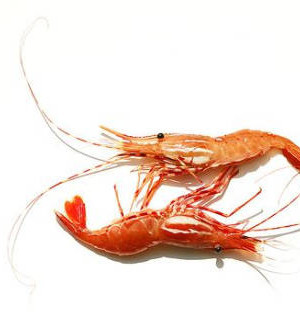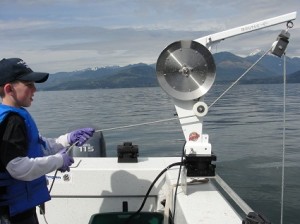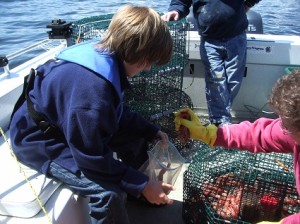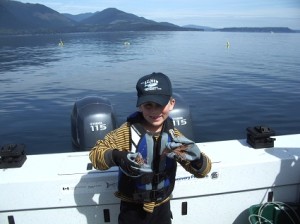Shrimping 101

One of the most popular fisheries in Washington State is the Shrimp fishery. It starts the first weekend in May, and is enjoyed by thousands of anglers and their families who are seeking to catch Spot Shrimp, the largest of the Shrimp species.
Spot shrimp are easily distinguished by the four white spots on their body. They can reach up to 10” in total length. While sport shrimping was at one time an 80 plus day season, with the growing commercial (both tribal and non-tribal) it is in some areas, only hours long, so be sure to check your regulations for the area you will be shrimping.
While shrimp are easy to catch, you must do a few things right or it can be a frustrating experience.
First of all, everyone shrimping must have a shellfish license. You are allowed 2 shrimp pots per licensed shrimper, but only 4 pots total per boat. Once the limit (80 shrimp per person) has been caught by everyone but one angler, you can only use two pots until that angler has obtained his limit. For rules and regulations, go here.
So, how do we catch shrimp? Let’s start at the surface. First of all, shrimp are diurnal. In other words, the brighter the day, the deeper they are. On cloudy, overcast days, you will find them in shallower water. Most spot shrimp will be caught between 125 to 250 feet deep. That is a lot of line hauling.
 Because of that, most avid shrimpers are now using the Ace Line Hauler or the Scotty Line Puller. They are fairly inexpensive compared to the commercial line haulers. They both fit on your Scotty Downrigger mount and plug into your Scotty power outlet. Since they are not gas powered, you don’t have the fumes, hot exhaust, gas on board, and you don’t have to yank at a starting rope.
Because of that, most avid shrimpers are now using the Ace Line Hauler or the Scotty Line Puller. They are fairly inexpensive compared to the commercial line haulers. They both fit on your Scotty Downrigger mount and plug into your Scotty power outlet. Since they are not gas powered, you don’t have the fumes, hot exhaust, gas on board, and you don’t have to yank at a starting rope.
Can you pull a pot by hand? Certainly, but you must remember, Shrimp are excellent and rapid swimmers. So, every time you stop pulling your pot to rest your arms or back, shrimp are leaving the pot. Scotty makes a small portable hand puller that is excellent.
Floats:
You are required to mark your shrimp pot with a yellow buoy, plainly marked with your full name and permanent address. I would also add your home phone number so that if your pot is lost, you can be contacted.
Beside the yellow buoy required, add a second float. It could be a bumper off your boat or other float. It only takes one large piece of kelp or a branch to drag your yellow float under the water.
Line:
 There are two types of line that are primarily used: 1) the yellow floating line and 2) Leaded line. With the yellow floating line, you must attach a lead weight down about 45 feet below the surface. No weight needs to be attached to a leaded line. I much prefer leaded line. It’s a little more expensive to start with, but lasts longer, is stronger and won’t end up in someone’s prop.
There are two types of line that are primarily used: 1) the yellow floating line and 2) Leaded line. With the yellow floating line, you must attach a lead weight down about 45 feet below the surface. No weight needs to be attached to a leaded line. I much prefer leaded line. It’s a little more expensive to start with, but lasts longer, is stronger and won’t end up in someone’s prop.
The problem with the yellow floating rope is that it floats. While, you must attach a weight to it to sink it, you still have an issue. Example: If you have 300 feet of rope and are fishing in 150 feet of water, with the right tide, the belly in the line can be picked up by a prop, another pot line being pulled, or a pot being dropped on top of it.
So, while a little more costly, you will be much more satisfied if you use leaded rope.
When using leaded line, use at least 25% more line than the depth you are shrimping.
Examples: Depth 150 feet – Use a minimum of 200 feet of leaded line
Depth 300 feet – Use a minimum of 400 feet of leaded line
With yellow floating rope, I would recommend at least 40% more rope than the depth you are shrimping.
Shrimp Pots:
Good shrimp pots are made by several different local companies. In my opinion the best ones on the market are made by SMI (Beau Mac). The SMI Pots are good quality at a moderate price. These pots are available at various sporting goods stores. The best prices I have seen recently have been at Costco.
Pots come, for the most part, in two styles. The first has a tunnel ramp. These are made for long soaks. So, in certain areas such as the San Juans or British Columbia, these will work fine. However, in Washington, where you may have a 4 Hour Shrimping day, they are not as effective, sometimes the Shrimp will come in so fast they will plug the funnel.
 The second style has a ramp entrance with several openings (commonly referred to as “fast catcher pots) which work the best for Puget Sound.
The second style has a ramp entrance with several openings (commonly referred to as “fast catcher pots) which work the best for Puget Sound.
Most importantly, weight your pots. Last year I picked up a Shrimp pot in 400’ of water, floating merrily along with 250’ of line attached. I picked this pot up 23 miles from where it was dropped. When I called the owner to return it, he told me “we don’t have any tides in my bay”. You certainly do! Also, a piece of kelp dragging on your line will certainly move your pot.
Use at least 12-20 pounds of weight or more and you won’t suffer from the “someone stole my pot syndrome”. Use your GPS to mark where you dropped your pot. Be sure to have a good depth sounder, no use dropping an expensive pot with 300 feet of rope attached into 400 feet of water.
While looking for a drop location, watch for clouds of bait on the bottom on your depth sounder. You can assume that the cloud is Shrimp. But, remember, Shrimp will move with the tide, and the amount of light. So, your next drop may be a few hundred yards away.
Let your first dropped pot soak for about 45 minutes. Then check your pot to see if your catch has been good. If it has, drop it again. Scatter your pots to start with, and as you find Shrimp, cluster your pots closer together. After you are satisfied that you have found a good Shrimp bed, check your pots about once an hour.
 Wet Bait: While a wide variety of baits are used, the most popular is canned cat food, or wet bait as it is often referred to. I usually use cat food with ocean whitefish and tuna in it. As it comes out of the can, cat food is too thick to be used alone, since we want it to send out a scent trail. As a result, it must be thinned out. The best thinner to use is Super Bait fish oil, which is usually available at Outdoor Emporium. In an emergency, Wesson oil will work for thinning. You want your cat food to just begin to ooze out of your bait container.
Wet Bait: While a wide variety of baits are used, the most popular is canned cat food, or wet bait as it is often referred to. I usually use cat food with ocean whitefish and tuna in it. As it comes out of the can, cat food is too thick to be used alone, since we want it to send out a scent trail. As a result, it must be thinned out. The best thinner to use is Super Bait fish oil, which is usually available at Outdoor Emporium. In an emergency, Wesson oil will work for thinning. You want your cat food to just begin to ooze out of your bait container.
Another good way to thin your cat food is to use Power House Bait Booster (hake oil) or Pautzke’s Crab & Shrimp Fuel, both sold by Outdoor Emporium in Seattle and Sportco in Fife. These oils send out a great scent trail.
 Dry Bait: In the last 3 years, dry pellets have come into wide use. The advantage of dry pellets is that shrimp will stay in the pot eating. With the Wet Bait, if they can’t get at the bait, they will leave.
Dry Bait: In the last 3 years, dry pellets have come into wide use. The advantage of dry pellets is that shrimp will stay in the pot eating. With the Wet Bait, if they can’t get at the bait, they will leave.
However, Dry Bait takes a little more preparation. Not much, but more. I prefer the pellets marketed at Sportco and Outdoor Emporium. The pellets, which are already pre-soaked in scent, need to be put in a blender and whirred around a bit. Then, I soak them in one of the above-mentioned oils for at least 12 hours. A bit longer if possible doesn’t hurt. I always mix it with more scent, or mix it with wet cat food: one cup of dry bait with three cans of cat food. Put more fish oil in until it reaches the consistency of heavy pancake batter. Or, simply use one container of mixed pellets and one of cat food. When mixing your wet bait (cat food), mix one cup of blended, pre-soaked Power House Pellets with three cups of cat food and one can of mackerel. mackerel could either be bought in cans and then mashed into the bait, or, you can buy frozen mackerel at most outdoor stores.
Taking care of your Shrimp Catch
 When you bring your pot aboard, carefully count them live into one-gallon plastic storage bags. Have each gallon bag clearly marked with the name of the person on your boat to whom they belong. A gallon bag will easily hold forty spot shrimp. Put them on ice. They will usually stay live for up to 5 hours. Don’t put them into melted ice water, as they will almost immediately die. ALWAYS keep your catch on Ice, not in melted ice water.
When you bring your pot aboard, carefully count them live into one-gallon plastic storage bags. Have each gallon bag clearly marked with the name of the person on your boat to whom they belong. A gallon bag will easily hold forty spot shrimp. Put them on ice. They will usually stay live for up to 5 hours. Don’t put them into melted ice water, as they will almost immediately die. ALWAYS keep your catch on Ice, not in melted ice water.
We usually start out by placing 20 in each gallon plastic storage bag, and then 20 in the next and so on. The idea is to be able to keep four pots working as long as possible. Once only one person is remaining to fill his limit, then you can use only two pots. By then it usually doesn’t make a lot of difference.
Once back at the dock or shore, a quick twist of the wrist will pop off the shrimp’s head. Fresh Shrimp at its best!
For freezing, twist the heads off, rinse and drain until dry on paper towels and freeze 20 – 40 shrimp per Quart Size Freezing Bag. These keep in our freezer until the next season. We always save one bag to use in April of the following year to remind us what a tasty treat we are going for in May.










